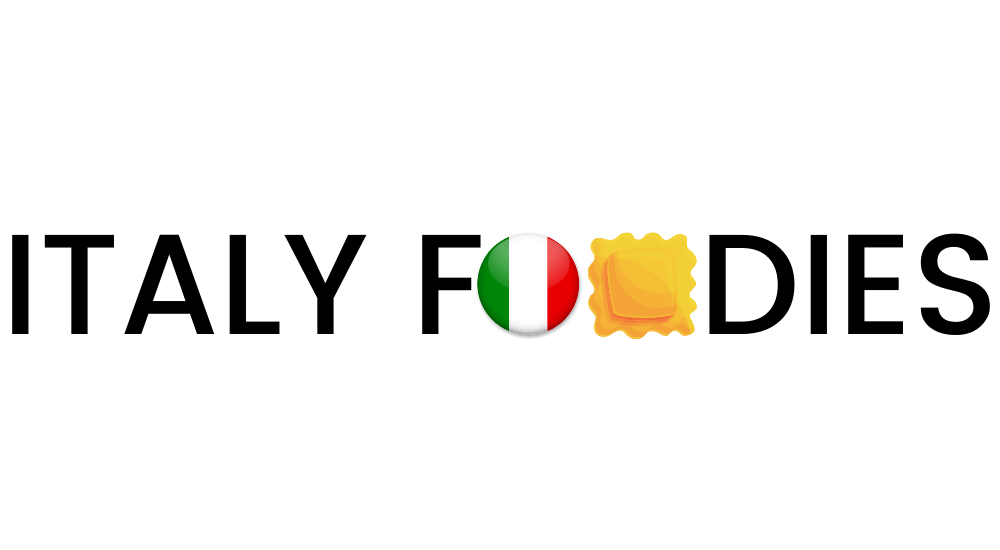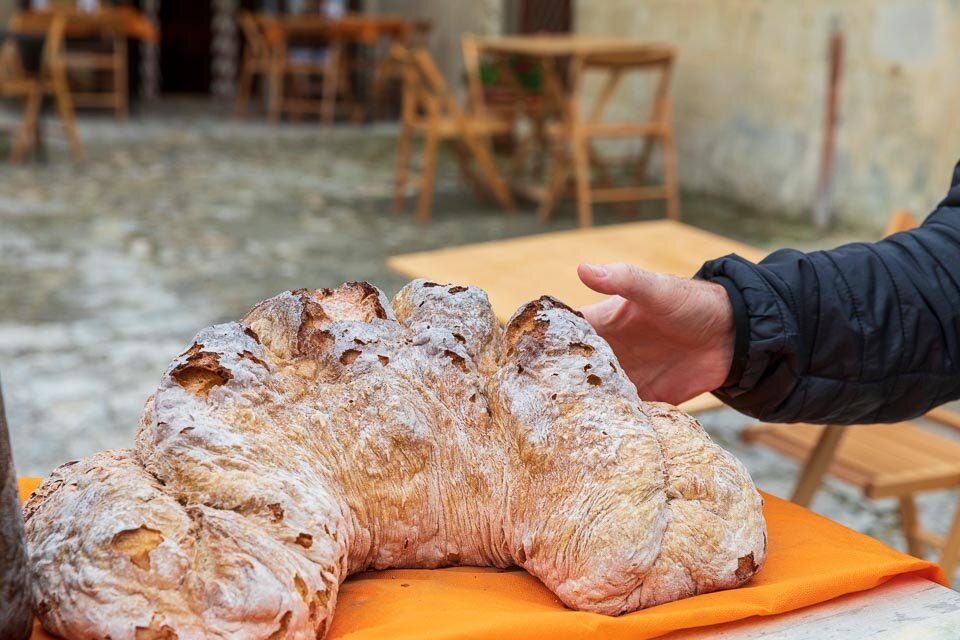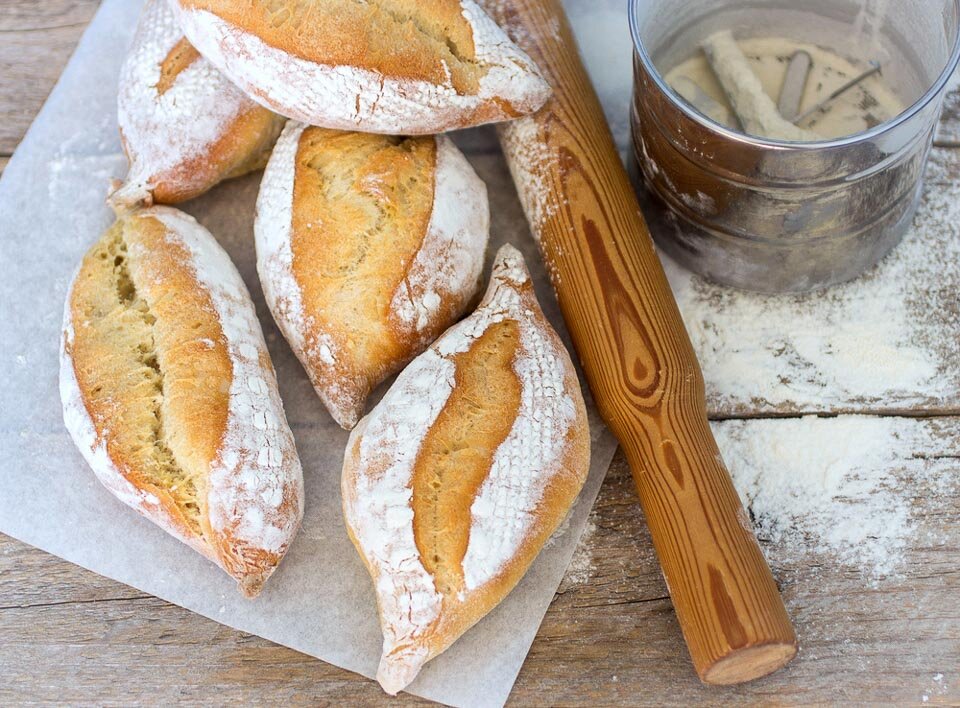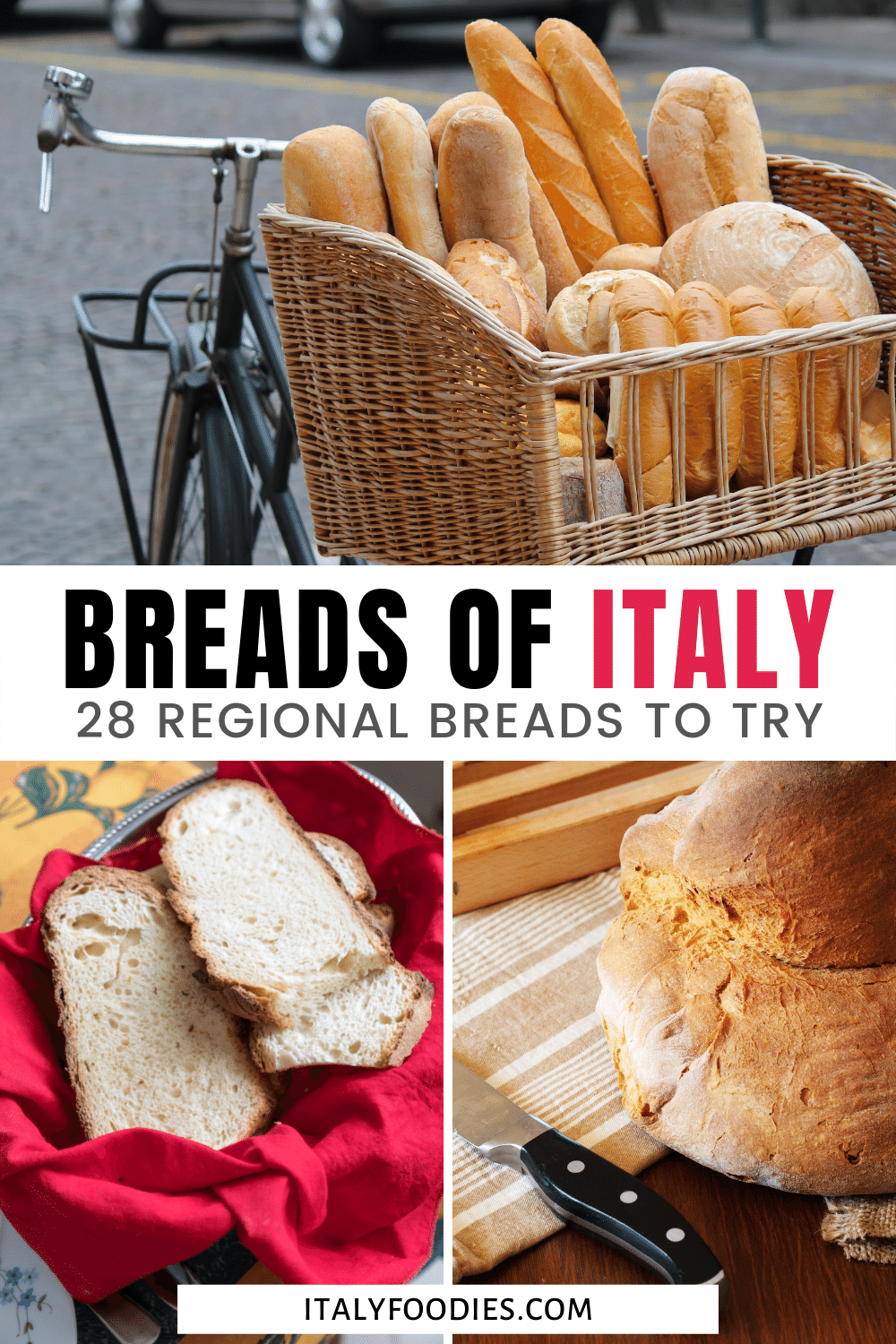Italian Breads: 28 Types of Italian Bread (+ Recipe) to Find Your Perfect Loaf
When you think of Italian food, you likely think of pasta and pizza. But Italian breads are also an important part of Italian cuisine.
There are over 350 types of Italian bread to devour so let’s dive into carb Heaven!
Each region of Italy produces its own unique types of Italian bread. Liguria and Puglia are famous for their focaccia, Basilicata is known for Pane di Matera, and Veneto boasts fantastic Ciabatta.
In recent years, Tuscany’s reputation for comparatively nondescript breads got a boost when it’s rustic Pane Toscano received the IGP designation (we share the recipe below).
It just depends on the locally produced ingredients of a given area, which of course depends largely on soil, climate and other factors.
Like wine, different types of Italian cheese and any traditional dish served, bread in Italy is regional.
If you’re a food and wine lover, savoring the unique breads made in Italy is just one more reason to get out and explore the different regions of Italy from north to south.
The more you see, the more you’ll understand just what goes into making one delicious loaf of bread.
If you’re looking for all of the best types of Italian bread, here’s a little bit of history about Italian bread types and where to find your perfect loaf!
Pane di Matera, one of the most recognizable Italian breads
History of Bread in Italy
Bread has been around for thousands of years, so you can imagine the history. For a time, however, the types of bread that could be made were rather limited, because of the basic wheat milling process.
Luckily, the ancient Romans stepped up and vastly improved the process. This change allowed Italians to create the type of flour that is still used today in white bread.
After that, the bread-making business boomed. In 100 BC, Rome boasted over 200 bakeries. 200 years later, Rome opened its own specialized baking school!
Since then, bread in Italy has become a primary staple served at every meal. There are about 350 types of Italian bread, and these delicious loaves are enjoyed with nearly every meal whether there’s meat, seafood, or a traditional pasta dish on the menu.
And while many Italian families bake their own bread at home, there are still approximately 20,000 bakeries all over Italy.
DOP/IGP Italian Breads
Most of the food you taste in Italy will be absolutely delicious, but how can you tell if something is really made in Italy?
The Italian government takes great pride and painstaking efforts to protect the authenticity of its most significant products, using the DOP system. DOP stands for Denominazione d' Origine Protetta, and translates to Protected Designation of Origin in English.
Food products receive the highest quality DOP designation and wines the DOCG designation, both of which are protected by EU law – a status which guarantees the authenticity of speciality foods from a specific geographic origin.
Still high quality but less stringent than DOP regulations, the IGP designation, or Indicazione Geografica Protetta (PGI Protected Geographical Indication) is another criteria which protects a product by being attributed to agricultural products and foods for which their quality, reputation or other important characteristic in a defined geographical area.
What’s the difference between DOP and IGP? The highest quality criteria of DOP means everything inherent to the origin, processing and packaging of the product must take place in the declared territory; whereas IGP products are a bit less stringent — to obtain IGP, at least one phase of the production process or one primary ingredient that makes that product unique must take place or originate in a particular area.
As of this writing there are just six regional DOP/IGP designated breads in Italy:
Pane di Matera from Basilicata, the ancient bread of Matera
Coppia Ferrarese, a type of sourdough bread first made in Ferrara in the 12th century
Sicilian Pagnotta del Dittaino DOP
Pane Casareccio di Genzano, the bread of Genzano in Lazio
Pane de Altamura from Apulia made from durum flour
Pane Toscano from Tuscany
These breads embody the Italian traditions of breadmaking using locally grown ingredients. Be sure and try them when you visit!
Recipe for Pane Toscano
Pane Toscano
Ingredients (makes one large loaf)
• 500 g bread flour
• 25g fresh yeast
• A pinch of sugar
• 310 ml of water
• One tablespoon of extra virgin olive oil
Preparation
Put the yeast into a bowl with a pinch of sugar. Stir in the water* and leave to ferment.
• TIP — water must be tepid, to ensure the success of the bread!
Put the flour in a large, wide bowl, or onto a work surface. Add the yeast a pinch of salt and the oil and mix in to incorporate well. Knead the dough for about 10 minutes, until you have a smooth, compact elastic ball.
Add a little more flour or water if necessary.
Put the dough into a lightly floured bowl, cover with a cloth and leave it to rise in a warm place for about an hour and a half, or until doubled in size.
Dust the work surface lightly with flour. Create and round shape loaf and place it on a lightly floured baking sheet. Cover with a cloth and leave in a warm place for 40 minutes until it rises.
Preheat oven to 200°C. Put the bread into the oven and bake for 40 minutes until lightly golden and crusty.
28 Types of Italian Bread (By Region)
Abruzzo
Spiga di pane
If you see spiga di pane in an Italian bakery, you’ll immediately want to buy it. Translated to “ear of bread,” this unique, almost-braid-like bread will quickly catch your eye.
And when you inevitably buy a loaf, you won’t be disappointed by the crispy exterior and fluffy interior.
Basilicata
Pane di Matera
In the region of Basilicata lies the crusty loaves that are considered to be the best bread in Italy: Matera bread, also known as pane di matera. With a crispy outside and a fluffy inside, it’s absolutely perfect! And we’re not the only ones who think so.
Matera bread is so good that it carries the IGP trademark, which means it can only be made in Matera. To add to the appeal, it has been recognized as a regional specialty by Slow Food.
MAde in Basilicata, Pane di Matera is crazy and rustic like the landscape.
Calabria
Filone
Filone is the Italian version of a French baguette, especially considering its long shape. It’s made with just five ingredients: flour, water, salt, olive oil, and yeast.
The resulting product is an everyday bread with a crispy outside and an airy inside.
Campania
Baba Rustico
Baba Rustico is one of the more unique types of Italian breads. Shaped like a bundt cake, this Italian bread looks sweet at first glance. But in reality, it’s quite savory!
In addition to the savory dough, Baba Rustico is often filled with savory meats and cheeses, including grated parmesan, cubed fontina, salami, or prosciutto cotto.
It’s a favorite Campania food and a must-try in Naples, Sorrento, and along the Amalfi Coast!
Emilia Romagna
Coppia Ferrarese
The cross-shaped, malt-flavored bread known as Coppia Ferrarese is a special find and you’ll find it often in Albinelli Market, the local market in Modena, the Quadrilatero in Bologna, and other food markets around Emilia Romagna.
the bread gets its name by joining together (or coupling, coppia in Italian) two strips of dough with a central piece.
As mentioned above, the Coppia Ferrarese carries the IGP trademark, which means at least one phase of the production process or one primary ingredient that makes that product unique must take place in Ferrara to be sold as Coppia Ferrarese.
Coppia Ferrarese, one of Emilia Romagna’s most endearing Italian bread types
Piadina Romagnola
Just like Coppia Ferrarese, Piadina Romangnola has also been awarded the IGP trademark. This lovely flatbread originally started as a dietary staple for the lower class.
It actually became a symbol of poverty when Italian poet Giovanni Pascoli wrote a poem titled La Piada about the bread.
The most common way to eat Piadina Romagnola is as a sort of flatbread sandwich, so not surprisingly it’s a favorite among Italy’s street foods. Sandwiches made with them are typically stuffed with tasty ingredients, like cured meats, cheeses, and even a bit of arugula.
Friuli-Venezia Giulia
Gubana
While many people know about Italian Christmas breads, there are also a couple of Italian Easter breads, including Gubana. Each slice of Gubana includes a gorgeous spiral pattern, created with the golden dough and the dark filling.
And Gubana tastes just as good as it looks! In addition to the fluffy dough, gubana also includes raisins, nuts, and candied orange peels.
If you’re traveled and eat in this northeastern region of Italy and beyond into western Slovenia, you’ll recognize some similarities between the Slovenian Gibanica and this Italian Gubana bread, right down to the name!
Gubana, a type of Italian bread made in the northeast region of Friuli-Venezia Giulia
Lazio
Ciriola
The Latium region is home to Italy’s capital city of Rome, which means there is plenty of good food in Rome and it gets to lay claim to many ancient Roman breads, including Ciriola.
Ciriola is an oblong-shaped bread that has been enjoyed for hundreds of years. This affordable bread was primarily eaten by the working class.
And instead of just eating the bread on its own, many people turn Ciriola into sandwiches filled with flavorful meats, vegetables, and cheeses.
Ciriola, one of Lazio’s most famous types of Italian bread
Pangiallo
Italian Christmas breads are one of the best parts of the Italian holiday season. And if you happen to be in Lazio, you’ll get to enjoy the sweet Christmas bread known as pangiallo.
Pangiallo actually has a long, storied past. A variation of this sweet bread was made by Pagan Romans during winter solstice to welcome the sun’s return. Eventually, pangiallo evolved into the delicious delight it is today, filled with nuts, spices, and candied fruits.
Liguria
Focaccia
Out of all of the types of Italian bread, focaccia may be the most well-known. This particular Italian bread hails from Genoa and the Liguria region, and has both a soft inside and a soft outside.
Sometimes the focaccia is served plain, while other times it has tasty toppings, like herbs, olive oil, or olives. My favorite way to eat focaccia is simply on its own, but it can also be sliced up to make fantastic sandwiches.
While it’s origins are in the foods of Genoa, you can find this delicious Italian bread all throughout Italy. These different regions may be even put a fun local twist on the focaccia toppings.
The flat Italian bread Focaccia is popular in Liguria, and also in Puglia
Pandolce
If you’re looking for an Italian Christmas bread, you’ll love pandolce. This Italian bread was first created in 16th century Genoa. Since then, it has become one of the best Italian Christmas breads around!
There are many quite a few variations to pandolce. This sweet bread can include everything from raisins to pine nuts to candied fruit to anise seeds.
Lombardy
Panettone
Panettone is the most well-known type of Italian Christmas bread, though you can find it year round and throughout northern Italy.
This Milanese treat is shaped like a wide cylinder and is filled with loads of sweet surprises, like raisins and candied fruits. Making Panettone is no easy feat either. It actually takes a few days, as the dough has to be cured (like sourdough).
Panettone is one of Italy’s traditional holiday breads
Marche
Pane di Farro
While many of the Italian breads on this list are made from wheat or other common grains, pane di farro requires a unique flour: spelt flour.
While it is similar to wheat, it technically does not fall in that category, which means pane di farro has a more unique, fiber-filled composition.
Molise
Focaccia di Patate
While focaccia is originally from Liguria, there are variations of focaccia throughout the country. One of the coolest variations is focaccia di patate, a type of focaccia made with flour, water, yeast, and boiled potatoes.
This potato-based focaccia is commonly topped with fresh tomatoes and onions.
Focaccia di Patate, one of the types of focaccia made in Molise
Piedmont
Grissini Stirati
You know those long, crispy breadsticks that you sometimes get to snack on at fancy restaurants? Those are Grissini Stirati! These hand-pulled breadsticks are already tasty enough on their own, but some bakers like to add a little bit of extra spice.
You can commonly find Grissini Stirati topped with sesame seeds, poppy seeds, or olive oil.
Puglia
Pane di Altamura
Pane di Altamura is a simple, yet fantastic Italian bread. It’s made with fine semolina flour and can be used in a wide variety of ways. Italians dip Pane di Altamura in olive oil, use it to make amazing sandwiches, and pair it with soups and stews.
As we mentioned above, Pane di Altamura has also been granted DOP (“Protected Destination of Origin”) status, which means that all Pane di Altamura must be created in the town of Altamura according to all rules and regulations. Strict rules make for delicious breads!
The famous DOP Italian bread of Puglia, Pane di Altamura
Pane Pugliese
Pane Pugliese is one of the most underrated kinds of Italian bread. For a long time, pane Pugliese was only eaten by the lower classes. But over the years, more and more Italians have started to enjoy this sourdough-like bread. T
he most popular way to eat pane Pugliese is as the base of a fantastic bruschetta.
Sardinia
Pane Carasau
Sardinia has some of the best bread in Italy, including Pane Carasau. This crispy, paper-thin flatbread is the perfect antipasto.
Topped with olive oil and sea salt, Pane Carasau is the ideal accompaniment to antipasto with stronger flavors, including sweet green olives and Sardinian sausages.
Pane con Gerda
Pane con Gerda also adds to Sardinia’s reputation as the place to savor delectable Italian breads. This golden, soft loaf is dotted with pork rinds for an extra burst of salty flavor. It’s absolutely delicious!
Pane Carasau, a flaky, flat Italian bread made in Sardinia
Sicily
Brioche col Tuppo
Sicilian food is known throughout the world and while brioche is originally French, the people of Sicily put their own spin on it with Brioche col Tuppo. French brioche is typically baked in a loaf, while Sicilian Brioche col Tuppo are small treats shaped like hats!
As if the fun shape wasn’t enough to convince you to try Brioche col Tuppo, the taste definitely will. The sweet, fluffy flavor makes them absolutely amazing on their own, without any butter needed.
But some bakers will add honey, orange rind, apples, or even saffron to the mix, making them an irresistable sweet treat.
Not to be outdone, however, Sicilians know how to elevate even the best foods — by adding gelato, the frozen delicacy of Italy. Can you imagine?
Gelato Brioche is one of Italy’s most famous street foods, and what’s even better is the rest of Italy knows and loves it too. But you can find this Sicily original throughout Italy. Grazie Sicilia!
Sicilian brioche is a favorite Italian, made better with a bit of gelato inside
Tuscany
Pane Toscano
Pane Toscano is one of the simplest types of Italian bread from Tuscany. With just flour, water, and yeast, it doesn’t seem like much. After all, it doesn’t even have oil or salt!
But the tasty flavors of Pane Toscano come from the overnight aging and the lengthy kneading processes.
Since Pane Toscano doesn’t have any salt or oil, that makes it the perfect pairing for oily and salty foods. Olive tapenades, cured meats, and flavorful cheeses are just a few examples.
Pane Altopascio
Like Pane Toscano, pane Altopascio is another saltless Tuscan bread. For that reason, it also pairs well with salty meats and cheeses – and Pane Altopascio has been enjoyed that way for hundreds of years, ever since it was invented in the Middle Ages.
Buccellato di Lucca
The little town of Lucca, Italy has its own special Italian bread to boast: Buccellato di Lucca. As a matter of fact, some Lucca locals say that you haven’t really been to Lucca if you haven’t tried it.
While most other Tuscan breads are savory, Buccellato di Lucca is a mouthwatering sweet treat filled with raisins and anise seed. Yum!
The sweet Tuscan bread, Buccellato di Lucca
Trentino-Alto Adige (South Tyrol)
Pane di Pasqua
Another eye-catching Italian Easter bread found in northern Italy is Pane di Pasqua. This braided bread includes brightly dyed Easter eggs as decoration! While the eggs in the center of the bread are edible, most people don’t eat them.
Rather, they are placed in the Pane di Pasqua for primarily aesthetic reasons. It’s one of South Tyrol’s most unique foods and an unmissable holiday treat .
Umbria
Torta al Testo
Torta al Testo, also known as crescia, is one of the only unleavened breads on this list. Made with just a handful of ingredients, Torta al Testo is used as a delicious bread-y pocket for cured meats and cheeses.
To spice up Torta al Testo, some bakeries add fun flavors to the dough, including sage, rosemary, and even turmeric.
Torta al Testo, an Italian recipe from Umbria. Homemade focaccia with corn flour, stuffed with chicory and pecorino or other ingredients and cooked on the "testo", a thick cast iron plate.
Torta al Testo, one of the more unusual Italian breads
Valle d’Aosta (Aosta Valley)
Pan Ner
You can already get a pretty good picture of Pan Ner from its name, which means “black bread.” This dark bread is made with rye and wheat flour, giving it a delicious earthy flavor.
To add a little bit of texture to the loaf, Pan Ner also has sunflower seeds, sesame seeds, and flax seeds mixed in.
Veneto
Ciabatta
Along with Focaccia, Ciabatta is one of the most internationally renowned types of Italian bread. It’s also surprisingly one of the newest types of Italian bread, as it was created in 1982.
Ciabatta was originally made to be an Italian competitor to the popular French baguette. The two are quite similar in flavor, although Ciabatta is slightly airier and sweeter.
Ciabatta is perfect for savory toppings in the cichetti bars of Venice
Pandoro
So far, we’ve included a few different types of Italian bread that are made for Christmas, including Gubana, Pandolce, and Panettone. But Veneto’s Pandoro sets itself apart from all of them.
First, Pandoro is made into a distinctive star shape, so it’ll immediately catch your eye.
And then, once you take a bite out of it, your taste buds will savor the delicious flavors of honey, vanilla, and lemon.
It’s one-of-a-kind and definitely a food you should try in the Veneto and northern Italy Christmas markets if you can!
***
With so many unique Italian breads, you might expect to add a few inches to your waistline after your visit. And that’s not including the pasta, cheese, desserts and other sweet treats you’ll gleefully devour.
Funny thing is, you usually don’t. You’ll find yourself walking more than usual and exploring in a way you probably don’t at home.
All that walking and good wine helps keep many Italians from packing on weight and it’ll do the same for you.
So Mangia and enjoy every loaf!

















